On its barely 415 square kilometers, there are about 200 magnificent palaces at the Centro Storico of Venice. In this post, I’m navigating you to the 50 most beautiful ones.
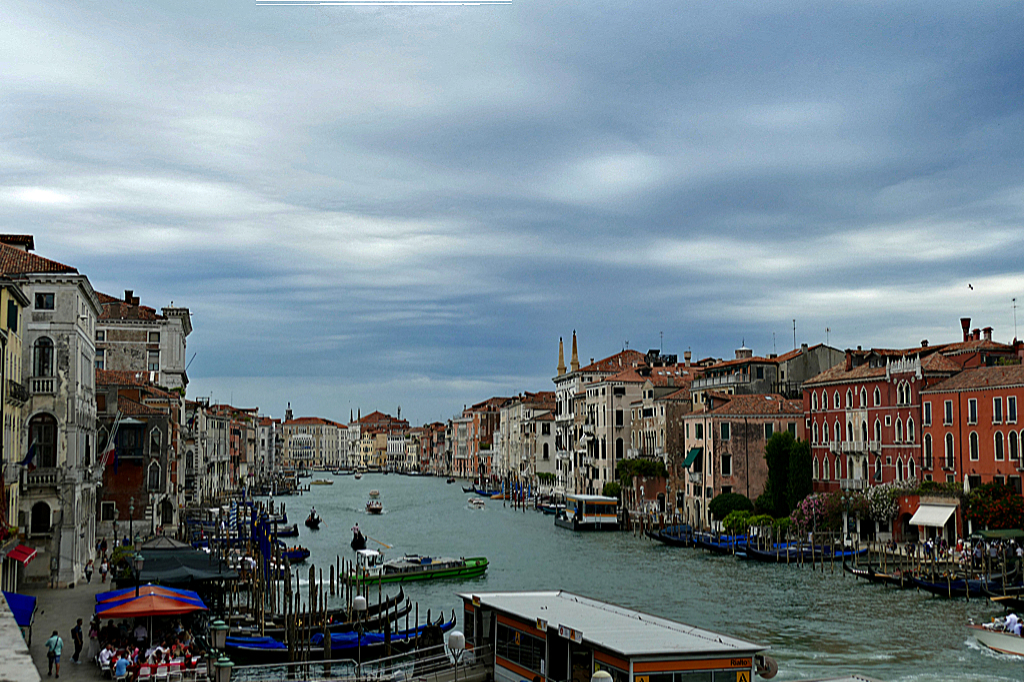
- Venice
- Centro Storico
- Palaces in Venice – How the Other Half Lived
- Most Beautiful Palazzi on the Canale Grande
- Fondaco dei Turchi
- Fondaco del Megio
- Palazzo Mocenigo Ca’ Nova
- Palazzo Erizzo alla Maddalena
- Palazzo Soranzo Piovene
- Ca’ Pesaro
- Palazzo Fontana Rezzonico
- Palazzo Miani Coletti Giusti
- Ca’ d’Oro
- Palazzo Giustinian Pesaro
- Palazzo Morosini Sagredo
- Palazzo Michiel del Brusà
- Palazzo Smith Mangilli Valmarana
- Palazzo Civran
- Fondaco dei Tedeschi
- Ca’ Fornoni
- Dogana da Terra
- Palazzo Dolfin Manin
- Palazzo Bembo
- Palazzo Loredan dell’Ambasciatore
- Palazzo Ravà
- Palazzo Barzizza
- Palazzo Gussoni Grimani della Vida
- Palazzo Bernardo
- Palazzo Vendramin Grimani
- Palazzo Pisani Moretta
- Palazzo Tiepolo
- Ca’ Foscari
- Ca’ Rezzonico
- Palazzetto Stern
- Palazzo Papadopoli
- Palazzo Giustinian Lolin
- Palazzo Cavalli-Franchetti
- Palazzo Barbaro Curtis
- Palazzo Contarini Polignac
- Palazzo Barbarigo
- Palazzo Venier dei Leoni
- Palazzo Dario
- Palazzo Barbaro Wolkoff
- Palazzo Orio Semitecolo Benzon
- Palazzo Salviati
- Palazzo Genovese
- Palazzo Ducale
- Palazzo Patriarcal
- Palazzo Caboto
- There’s More
- How to Visit the Palaces of Venice
- Venice Entrance Fee
- Legal Trespassing
- Map
- Pinnable Pictures
Venice
I still find it mind-blowing that cozy little Venice was one of the largest European cities. Until 1797, it was the capital of the Republic of Venice and one of the most important trading cities. Venice maintained the largest number of merchant ships as well as warships. It ruled over a colonial empire that stretched from northern Italy all the way to Crete. Definitely some kind of an amazing world power.
However, in 1798, it came under French and Austrian rule before it became part of Italy in 1866.

The respective doge was the head of state. He was elected in a complicated yet very democratic process. The first vote had the people’s assembly and only then voted the nobles. However, the latter monopolized the most important positions and profited from trade’n’commerce. The rest of the population was basically banned from long-distance trade.
Centro Storico
In the Venetian lagoon, firm clay soil underneath the mud facilitated the construction of buildings. As a matter of fact, fundaments were built on millions of wooden poles. In total, 127 islets form the old town of Venice.

On these pontoons are the foundation walls. To save weight, the buildings were constructed from hollow clay bricks. Despite huge efforts, today, many buildings are in very poor condition. Firstly, since the end of the Republic of Venice, the maintenance of buildings and canals has been neglected.

Also, the currents in the lagoon caused by the ebb and flow of the Adriatic were additionally intensified by the dredging of deep shipping channels for the cruise ships. Hope you feel bad, you cruise ship passengers!
Palaces in Venice – How the Other Half Lived
Funnily, during the Republic of Venice, a palace was modestly referred to as a casa, abbreviated to ca′. Officially, there were only two palaces in the city. Those were the Palazzo Patriarcal, the residence of the Patriarch of Venice, and the Doge’s Palace, obviously.
Today, only a few examples of byzantine palaces from the 13th and 14th centuries have survived. Also, most of them underwent thorough remodeling in the 19th century. For instance, you can still see on today’s town hall Ca’ Farsetti where the goods were once disembarked on the ground floor. Furthermore, you can clearly spot the piano nobile, or bel étage, with its round arches. Nevertheless, the decorative details date from the 19th century.

Especially along Venice arterial waterway Canal Grande, architects decorated the Ca’s with the so-called Gotico Fiorito.
Until the 18th century, Venetian architects stuck to the construction of traditional palaces. The last stately edifices were Ca’ Pesaro, Ca’ Rezzonico, as well as the Palazzo Grassi. Today, all three palazzi are housing museums.
Lost And Found
In the 19th century, the Venetian palace architecture suffered some severe losses. Many palaces suffered despoilment and vandalism.

However, new owners succeeded in conserving the interior as well as the exterior of some of the palaces.
For instance, a polychrome painted decoration of the Ca’d’Oro was discovered and restored in the 1990s. Sadly, in other cases, people had amateurishly painted over large surfaces of Gothic friezes. Obviously, this destroyed them for good.
Today, only paintings from the 15th and 16th centuries prove how intensively polychrome the Byzantine and Gothic architecture really was at that time.
Most Beautiful Palazzi on the Canale Grande
Claiming to know what the most beautiful palaces are might sound a bit preposterous, obviously. Different strokes for different folks, I know. However, I handpicked 50 of my favorite palaces in Venice. Below, I’m introducing them by briefly summarizing their history.
Most of them stand alongside the Canale Grande, obviously. After all, the wealthy aristocratic families wanted everybody to see their funds’n’fortune. Hence, they did not hide their palazzi behind bushes in some backyard.
To this date, those palaces are next to each other like beads on a string. Therefore, I’m suggesting you admire them from the rear of a vaporetto. Start your ride somewhere around the train station Santa Lucia. Then, as you glide down the Canale Grande, you’ll see 45 of the palazzi listed below. I’ve detailed them in descending order the way you see them during your cruise. This way, you shouldn’t miss any of them. Also, the map at the end of this post will help with your orientation.
Fondaco dei Turchi
The Fondaco dei Turchi dates back to around 1225. It served as a trading house for Ottoman traders, who the Venetians generically referred to as Turks. Fondaco, however, goes back to the Arabic word funduq which translates to warehouse.
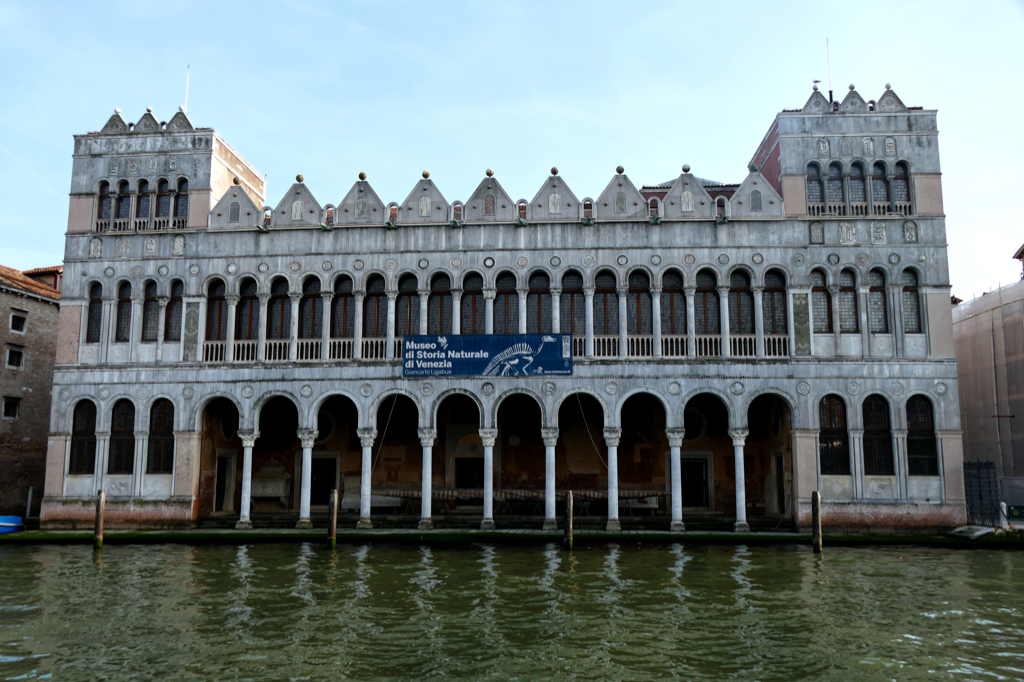
Today, it is owned by the city and houses Venice’s natural history museum.
Fondaco del Megio
The Fondaco del Megio is a former millet granary, built in the 14th or early 15th century. The façade, the only original part that’s left of the building, is made of brick and faces the Grand Canal. The side façade, however, faces west towards the Fontego dei Turchi.

Only a few decorative elements, such as a national emblem with the lion of Saint Mark, are embellishing the building. Today, it houses a primary school.
Palazzo Mocenigo Ca’ Nova
This palazzo is actually a complex of palaces. You can actually see how inhomogeneous its façade is. It consists of four buildings.
Two of them once were a dwelling house. The Palazzo Mocenigo Nuova, however, was the home of another branch of the family from Milan. Built on the site of a 15th-century medieval house, it is actually the newest part of the complex. Also, it was the very first property of the Mocenigo family
Palazzo Erizzo alla Maddalena
In 1650, the building passed to the Erizzo family through the marriage of Giacomo Erizzo to Cecilia Molin. It has undergone numerous refurbishments.

The main façade still shows a Gothic style. However, there are numerous lancet windows. Among them, the quintuple window on the main floor stands out as it is shifted to the left.
Palazzo Soranzo Piovene
This building dates from the first decades of the 16th century. Later, the Soranzo family bought the palace. They passed it to the Piovene family through the marriage of Cecilia Soranzo and Girolamo Piovene in 1760.
Today, it houses the Guardia di Finanza on the main floor as well as on the mezzanine.
The remaining parts of the palace around the central courtyard and beyond are private residences. Also, there is a small theater on the ground floor.
The palace has a garden as well as a courtyard with a fountain. Inside, the atrium and the staircase are particularly noteworthy.
Ca’ Pesaro
Interestingly, the more precious façade is facing the Rio delle Du Torri and not the Canale Grande. However, reliefs and grotesque masks adorn the entire façade. It gives you an idea of how magnificent the interior used to be. Yet, hardly anything has survived. However, preserved are frescoes by Giovanni Battista Pittoni and Giovanni Battista Tiepolo.

Today, the palace houses the Galleria Internazionale d’Arte Moderna on its first floor. There you can find admire paintings by Marc Chagall, Wassily Kandinsky, Gustav Klimt, Henri Matisse, and many other modern artists.
Another museum, namely the Museo d’Arte Orientale, is on the second floor. Here you get to see about 30,000 objects originating from Japan, China, and Indonesia.
Palazzo Fontana Rezzonico
The first owner of this palace was the Fontanas family. They were wealthy merchants from Piacenza who had settled in Venice in the 16th century. They wanted to have their very own’n’original palace. Therefore, they acquired a building that was on the very spot. Eventually, they demolished that perfectly fine structure just to make way for the current palace.

At the end of the 17th century, the Rezzonico family rented the palace. They were waiting for the completion of their own palace. Carlo della Torre di Rezzonico, later Pope Clement XIII, was born in the Palazzo Fontana Rezzonico in 1693.
Like many other Venetian families, the Fontanas were forced to sell their palace due to the financial crisis following the fall of the Republic of Venice. The banker Johann Conrad Reck bought it and sold it later to the Levis family. Today, it belongs to the Sullam family.
Palazzo Miani Coletti Giusti
The palace was built in 1766. It has changed hands several times, belonging to the Miani family, to the Colettis, and to the Giustis.

The palace has a linear, greenish façade and four floors. Distinctive features are the four portals facing the water. Doric-style half-columns surround the façade. In three niches are statues of well-known men of the time.
Both, the Palazzo Miani Coletti Giusti and the Ca’ d’Oro are housing the Galeria Franchetti.
Ca’ d’Oro
The Ca’ d’Oro owes its name Golden House to the elaborate cladding of polychrome marble, its originally ultramarine color, and the gilded stone carvings on the façade facing the canal. The palace is a great example of early 15th-century Venetian Gothic architecture.
In 1895, baron Giorgio Franchetti bought the Ca’ d’Oro. He restored the dilapidated house and put his art collection in the renovated building. Then, in 1915 he donated the building and his collection to the Italian state. The Galleria Giorgio Franchetti alla Ca’ d’Oro was founded after Franchetti’s death in 1927.
The interior is no longer original due to the long period of neglect. During the restoration, some rooms were fitted with ceilings from other palaces. The rooms are furnished with antique furniture. This way, they give you an impression of the splendor of former Venetian living culture.
The art collection includes paintings by Andrea Mantegna, Giovanni Domenico Tiepolo, and many others. In addition to paintings and sculptures, you can also admire handicrafts and carpets.
Palazzo Giustinian Pesaro
This palazzo was built at the end of the 14th century. The façade overlooking the large garden was remodeled in the 18th century. In the 19th century, the entire Gothic building was refurbished.

The quadruple windows are offset from the center to the right and appear asymmetrical. All windows have keel arches and are surrounded by indented frames decorated with flowers on the tops. However, the balconies are only from the 19th century.
Palazzo Morosini Sagredo
The Sagredo family bought the palace from the Morosinis in 1661. At the beginning of the 18th century, Gerardo Sagredo, Procurator of San Marco and relative of Doge Niccolò Sagredo, bought the palace.

After the death of the last descendant of the family, numerous works of art from the house were sold.
Inside, the Homage to Venice by Giovanni Battista Tiepolo survived in poor condition. The artists had already worked for the Sagredo family in the 1730s. Also, he frescoed Doge Sagredo’s chapel at the church San Francesco della Vigna.
Palazzo Michiel del Brusà
In 1774, the palace of the Michiel family was set on fire and devastated by the carelessness of a servant.

It was subsequently rebuilt thanks to funds granted by the Republic of Venice.
Palazzo Smith Mangilli Valmarana
The palace is best known for having been the residence of the British Consul Joseph Smith. He was also Canaletto’s agent and sold his paintings to the British.
Originally the palace was a Byzantine-Gothic building. When it became the British embassy and residence of Joseph Smith, he had it remodeled in the style of the time. However, the new façade only reached up to today’s first main floor.
In 1784, Count Giuseppe Mangilli purchased the palace. He added the upper floors and commissioned Gian Antonio Selva to remodel the interiors. He created a luxurious and unique ambiance in the classical style, which is still perfectly preserved to this date.
Palazzo Civran
The Civran family commissioned this palace at the end of the 14th century. As a result of the last major restoration in the 17th century, it shows mainly the late Renaissance style.

Today, the Palazzo Civran belongs to the Republic of Italy and houses the Guardia di Finanza.
Fondaco dei Tedeschi
The Fondaco dei Tedeschi was a trading house of German merchants. The building was first mentioned in 1228. However, an institution with a similar function probably existed before.

In 1505, a fire damaged the building, but the city of Venice paid for the reconstruction. No less than Titian and Giorgione frescoed the façade. Sadly, these works cannot be seen anymore. The German merchants in Venice also commissioned a large picture from the German Renaissance artist Albrecht Dürer.
Ca’ Fornoni
If you can splurge, switch to holiday-happy mode at the Ca’ Fornoni*. If you choose the spacious and gracious apartment, you have a million-dollar-view. Also, you’re located right on the so-called Riva del Vin, the embankment of wine.

The owner transformed his family’s apartments into a prestigious lodging option. Here, you enjoy the comfort and authenticity of a Venetian home away from home.
Dogana da Terra
Just like other buildings in the Rialto area, the Dogana da Terra suffered the consequences of the fires that often ignited in the neighborhood.
The palace was reconstructed in 1531 and subsequently restored. Demolished in 1842, the architect Lorenzo Santi rebuilt it in 1843.
Palazzo Dolfin Manin
The Dolfin family commissioned the palace in 1536. Zuane Manin, sole heir and follower of Doge Andrea Gritti, was a high official in Verona. Upon his return, the family’s two medieval houses were replaced by only one, yet far more representative palace.

In the 17th century, the Dolfin family first rented out the palace. However, later they actually sold it piece by piece. The new owners were members of the noble families Pesaro, Venier, Dolce, and Correggio. Finally, the Manin family lived in the palace’s piano nobile in the early 18th century.
Palazzo Bembo
The Bembo family commissioned the palace in the 15th century. Over the centuries, it has undergone several modifications mainly on the inside. Nevertheless, apart from the attic, the outside has retained its original appearance.

Today the palace houses the headquarters of a hotel group and an exhibition space for contemporary art. I’ve often visited this venue during the Biennale di Arte, Venice’s major art event.
Palazzo Loredan dell’Ambasciatore
The Loredan family, who owned the palace, was one of the most illustrious clans in Venice. Leonardo Loredan became a Doge in 1501. Also, Francesco Loredan was granted this honor in 1572.

Hence, the Loredans’ noble residence dates back to the second half of the 15th century. Since the palace housed the Austrian embassy for 29 years during Francesco Loredan’s tenure as Doge. This earned the palace the suffix dell’Ambasciatore since ambassador Filippo di Rosenberg Orsini lived there from 1754 on.
From 1764, Count Giacomo Durazzo, a member of an old Genoese family and imperial ambassador in Venice, lived there with his wife, an Austrian noblewoman.
A fire destroyed the palace in 1891. However, it was immediately reconstructed.
Palazzo Ravà
The neo-Gothic palace with a crenelated parapet on the right side was built in 1905. It replaced an older building from the 16th century.

The palace has four floors. The ground floor with dark gray rustication has various rectangular windows and doors. A cornice separates it from the upper floors. The rest of the façade is plastered and painted red.
Palazzo Barzizza
Initially, the palace was planned as a warehouse in the 13th century. It belonged to the Contarini family. In the 16th century, the building was remodeled and modernized.

In the 18th century, the Barzizza family purchased the palace.
The façade has been restored and remodeled many times over the centuries. Therefore, it is slightly asymmetrical and full of clashing features.
Palazzo Gussoni Grimani della Vida
The Gussoni family commissioned the palazzo in 1548. However, this family had already lived in Venice since the end of the 11th century.
The palace housed the English embassy from 1614 to 1618.

In 1735, Senator Giulio Gussoni died. He was the last member of the Gussoni family.
Subsequent owners were the Grimanis. They bought the palace in the 18th century. Eventually, it belonged to Cesare della Vida, a wealthy businessman of Jewish origin.
Finally, the palace was handed over to the government. Today, it is the seat of the Regional Administrative Court of Veneto.
Palazzo Bernardo
The Bernardo family commissioned this palace around 1442. In 1651, they sold the building to Bortolo Bellotto, a wealthy skin and fur dealer.
While the owners changed a couple of times, the structure of the palace gradually disintegrated. However, a major restoration took place in 1998.

The current owners are the Avogadro Degli Azzoni family, aristocrats from Treviso.
Palazzo Vendramin Grimani
The Doge Pietro Grimani resided at this magnificent palace in the 17th century.

The Fondazione dell’Albero d’Oro has restored the magnificent home of Pietro Grimani for two years. You can visit it on guided tours that highlight the precious furnishing and decoration including stuccos and frescoes, tapestries, and art collections ranging from the 16th and 18th centuries. In addition, there are also exhibitions by artists in residence and contemporary art.
Palazzo Pisani Moretta
The Bembo family commissioned the palace in the 15th century. In 1629, the palace passed to a branch of the Pisani family.
Francesco Pisani Moretta’s daughter Chiara inherited the palace after the death of the family’s last male heir in 1737. She had the external staircase removed, a salon built by Andrea Tirali, and the interior decorated by the most important painters of her time.
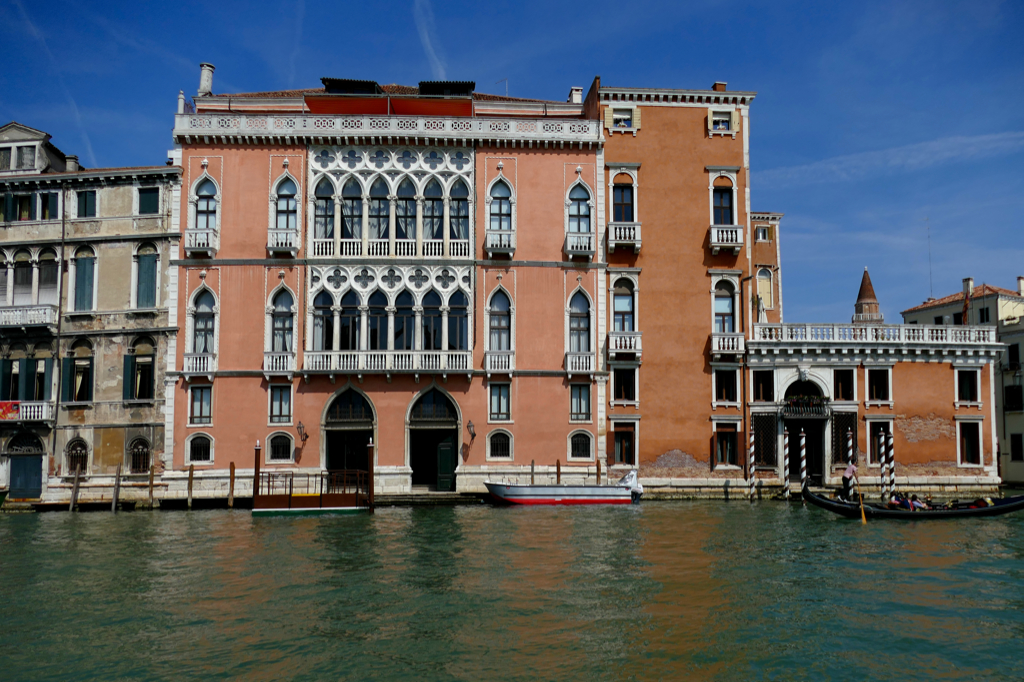
Then, after a changeful history and many different owners, the palazzo passed to the Sammartini family in 1962. They still own the palace.
During the yearly carnival, they rent it out as a festive venue – but also for festivities and congresses.
Palazzo Tiepolo
The Querini family commissioned the palace on the site of an older palace in the 16th century.

The architect built the palace in the Renaissance style with two piani nobili, bel étages.
The remains of the frescoes by Andrea Meldola are still decorating the façade. Also, Jacopo Guarana decorated the reception hall with frescoes.
To this date, the palace is privately owned.
Ca’ Foscari
At the time of its construction, the Gothic palace Ca’ Foscari was the largest private house in Venice. Together with the neighboring palazzi, it formed a coherent building complex.

The Foscari family-owned of the building until 1845. Then, they sold it to the municipality of Venice. The city used the palace as accommodation for high-ranking visitors. Among the illustrious guests were for instance the French King Henry III. and Ernst August of Hanover.
During the Austrian occupation of Venice, the military used the palace as barracks. Obviously, this caused great damage to the building, especially on the inside.
In 1868, the Ca’ Foscari became the seat of the Royal Commercial College.
Today, you can visit the palace on a free guided tour.
Ca’ Rezzonico
The wealthy Rezzonico family from Lake Como bought into the Venetian nobility with 100,000 ducats in 1687. They commissioned the palace in 1750. In 1758, Carlo Rezzonico became Pope Clement XIII. Hence, the new building came at the right time for the now papal family to fulfill their representational duties.

After the fall of the Republic of Venice, the family suffered financial problems. Consequently, they sold the palace. In 1885, the son of the poet Robert Browning acquired the Ca’ Rezzonico as a home for his elderly father. After his father’s death, he sold the palace to Baron Hirschel de Minerbi in 1906.
Finally, the city of Venice acquired the palace in 1935.
Today, it houses the Museo del Settecento Veneziano. You get to see paintings and frescoes by Pietro Longhi, Canaletto, Francesco Guardi, and father and son Tiepolo, among others. However, there are also sculptures and interior decorations from the 18th century.
Palazzetto Stern
The Palazzetto Stern goes back to very ancient origins. The Malpaga family commissioned the Venetian-Byzantine two-storey structure in the 15th century.
Having fallen into decay over the centuries, the Stern family bought it in the early 20th century. Ernesta de Hierschel Stern commissioned renowned architects for the expansion and renovation of the palazetto. Palazetto translates to small palace, by the way.

The craftsmen used old materials for the conversion and extension of the existing building.
Today the building, which started out as a private residence, has been transformed into the luxury Hotel Palazzo Stern*.
Palazzo Papadopoli
The Coccina family commissioned the palazzo around 1580. In the 18th century, Giovanni Domenico Tiepolo embellished the second piano nobile with frescoes.
In 1837, the building came into the possession of the extraordinarily wealthy grain dealer Valentino Comello. Since he had been one of the most important financiers of the uprising against Austria, he went into exile in 1849.

Counts Nicolò and Angelo Papadopoli bought the palace in 1864. Their family came from Corfu and had risen to the Venetian nobility in 1791.
In 1922, the Arrivabene Valenti Gonzaga family acquired the palace through marriage. Actually, they have lived in the palace ever since.
In 2007, they rented parts of the building to a Swiss group of investors who want to convert it into a hotel.
Palazzo Giustinian Lolin
The palazzo stands on a 14th-century foundation.
The Giustinian Lolin family commissioned the palace in the 17th century. It is an early work of the Venetian architect Baldassare Longhena.
The façade of the building is symmetrical and follows a classical design with two so-called serlianas, classic Venetian windows, placed in a central position in the piano mobile, hence, bel étage.
Palazzo Cavalli-Franchetti
In 1840, Archduke Friedrich Ferdinand bought the Palazzo Cavalli-Gussoni from the 16th century. Baron Franchetti had the palace rebuilt in 1896 by the architect Camillo Boito, who remodeled the rear wing of the building and the staircase in a neo-Gothic style. Finally, in 1922, the property went to the bank Istituto Federale di Credito

Since 1999, the palace has been another seat of the Venetian scientific and cultural institution Istituto Veneto di Scienze, Lettere ed Arti, together with the nearby Palazzo Loredan.
Palazzo Barbaro Curtis
The Palazzo Barbaro Curtis dates from 1425. Bartolomeo Bon built this posh residence for the noble Spiera family. As the family died out, Zaccaria Barbaro purchased their palace.

The right part, added in 1690, houses a wonderful ballroom. Giambattista Tiepolo was in charge of the interior decoration. Sadly, over the course of the 19th century, its frescoes vanished.
The Barbaro family died out in the second half of the 19th century. Eventually, the Curtis-Conte family bought the palace and they still own it today.
Palazzo Contarini Polignac
Around 1550, a member of the Contarini dal Zaffo family purchased the palazzo. This clan had provided the Doge of Venice eight times.

The palace remained in their possession until 1783. Then, they sold it to the wealthy merchants Manzoni. In 1900 Winnaretta Singer, a millionaire heiress and Princesse de Polignac, acquired the palace. Later, her nieces inherited the building which belongs to the family to this date.
Singer purchased Domenico Tiepolo’s frescoes from the Palazzo Correr a Santa Fosca. For their new owner, they were transferred to canvasses. She also had an Erard grand piano brought from Paris. In her era, the Palazzo became the hotspot of musical soirees, at which, among others, Enrico Caruso, Arthur Rubinstein, and Vladimir Horowitz performed.
In 1908, Claude Monet painted the façade of the palace from a gondola.
Palazzo Barbarigo
Palazzo Barbarigo is a fine example of a 16th-century Renaissance palace. It has one of the most outstanding façades on the Grand Canal. The Testolini brothers, owners of the Fratelli Testolini glass factory, commissioned the outstanding Murano glass mosaics on its façade in 1886.

Today, the Russian conductor Valeri Gergiev owns not only the palazzo but also the adjoining building.
Palazzo Venier dei Leoni
The Venetian Venier family commissioned Lorenzo Boschetti, the architect of the Church of San Barnaba, to build their palace. Various Doges in the 15th and 16th centuries stemmed from this family.
Nevertheless, the family’s financial means were not sufficient for the ambitious project. Hence, Boschetti finalized only the first floor. However, a model of the palazzo is in the Museo Correr.

Over the decades, the building fragment had different owners. Luisa Casati, a patron of the arts and longtime lover of the writer Gabriele D’Annunzio, owned it at the beginning of the 20th century. In 1949, Peggy Guggenheim acquired the palazzo for herself and her extensive art collection. She lived there until her death in 1979. Guggenheim endowed the collection and palazzo to the Solomon R. Guggenheim Foundation. They opened the building to the public as a museum in 1980.
The graves of the last owner and her many pets are in the garden.
Palazzo Dario
Another superstar among Venice’s palaces is Palazzo Dario or Ca’ Dario. The body is built in the typical Italian Gothic style. However, the façade facing the Grand Canal stems clearly from the Renaissance.
Giovanni Dario, at that time secretary of the Senate of the Republic of Venice, commissioned the palace in 1479. When Giovanni Dario died in 1494, his nephew Vincenzo Barbaro inherited the palace.

The Barbaro family kept the palace until the early 19th century. Then Alessandro Barbaro sold it to an Armenian merchant.
In 1908, Claude Monet used the building as the basis for a series of paintings. He didn’t change the perspective, but painted under in different lighting conditions.
The palace is privately owned and therefore not open to the public.
Palazzo Barbaro Wolkoff
The building, initially constructed in the Venetian-Byzantine style, was remodeled in the 15th century adding Gothic elements. In 1894, the world-famous actress Eleonora Duse lived on the top floor of the palace as Alexander Wolkoff Mouronzov’s guest.
Palazzo Orio Semitecolo Benzon
The old-established noble Orio family commissioned the palace in the 14th century. After the construction of the neighboring Palazzo Salviati in the 20th century, the two palaces were connected.

The predominantly Gothic façade shows its own character on each of its four floors. The first floor follows the 14th century style, the second that of the 15th century. Finally, the top floor was added in the 19th century.
Palazzo Salviati
The architect Giacomo dell’Olivo finished the building as a shop and furnace for the Salviati glass factory in 1906. In 1924, the small palace underwent a major restoration, which consisted of adding one storey and installing a large mosaic in the façade.
On the ground floor are three large arches. The central one is the portal to the canal. Above, you can spot the towner’s name Salviati.
Palazzo Genovese
The Genovese family commissioned the architect Edoardo Trigomi Mattei to build the palace as their Venetian home in 1892.
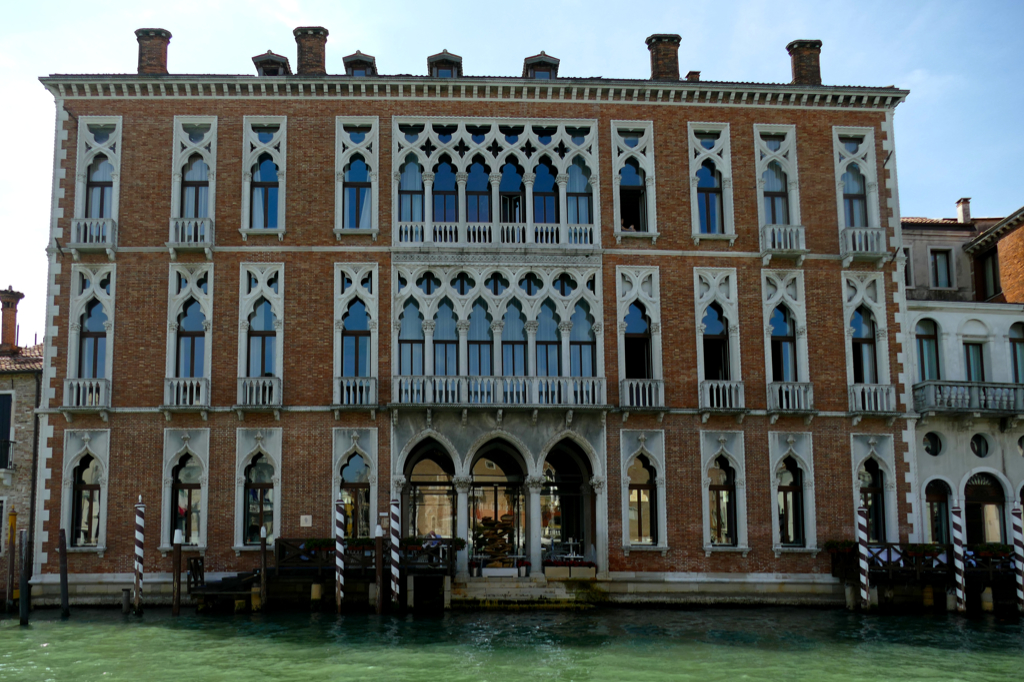
After a long period of decay, the building was remodeled and converted into a luxury hotel in 2009.
Palazzo Ducale
The Palazzo Ducale, hence Doge’s Palace, is one of the most important secular Gothic buildings and a masterpiece of Venetian architecture. It has been the seat of the Doges. They were the governmental and judicial organs of the Republic of Venice since the 9th century. Obviously, the palace was also a symbol of the size and power of the maritime republic of Venice. The oldest part faces the water.
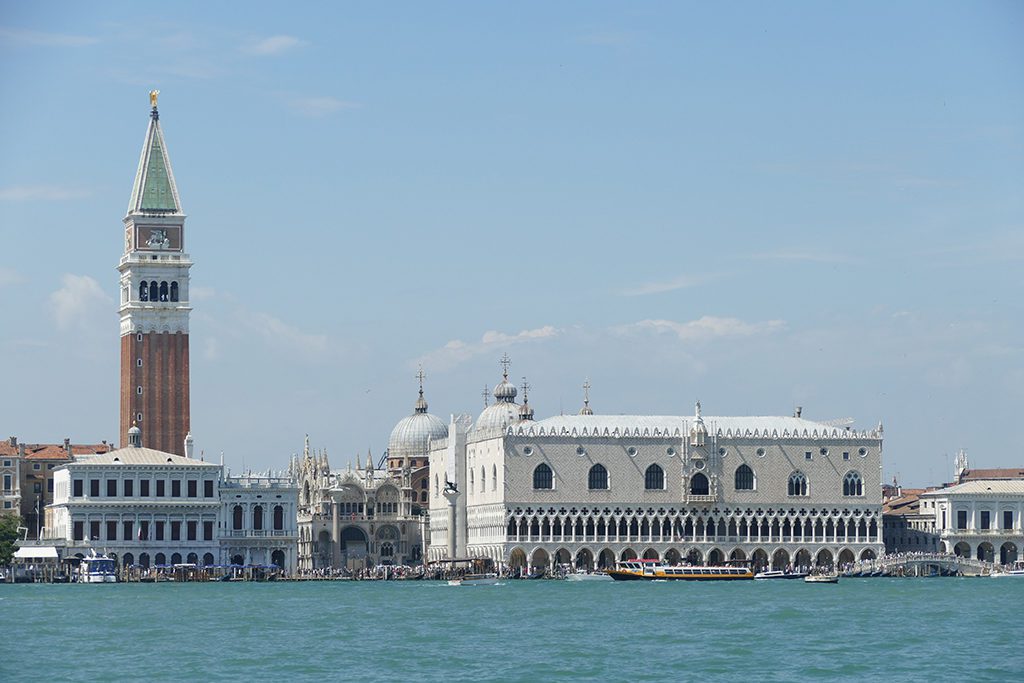
But also the palace’s interior decoration reveals Venice’s wealth and power. Apart from precious stucco and gilded carvings, there are historical portraits and allegories painted by some of the greatest Venetian artists.
The new prisons, the so-called Prigione Nuove, were added between 1563 and 1614. The famous Ponte dei Sospiri, the Bridge of Sighs, connects the prison to the palace’s north wing and the courts.
In the north, the complex borders directly on Saint Mark’s Basilica.
Palazzo Patriarcal
Originally, this building was part of the Doge’s Palace complex. Monopol built the palace to house a new banquet hall needed for the receptions of the Signoria of Venice and the Senate in the early 17th century.
After the fall of the Republic of Venice, the palace became the new seat of the Curia.
Palazzo Caboto
Arguably, Giovanni Caboto was the first modern European to reach the American continent in 1497. Coming to Venice as a boy, he became a citizen but left the city for Spain.

In the service of the English King, he undertook three voyages to find the sea route to Asia.
There’s More
Palazzo Soranzo
The Soranzo family commissioned the palazzo in the 14th century. They were a powerful noble clan. One member was even a Doge of the Republic of Venice and 16 procurators, hence, high-ranking officers. Giovanni Soranzo let no less than Dante Alighieri stay at the palace.

An old palace to the left and the new one to the right form today’s palazzo. Since both parts are built in Venetian Gothic style and are also painted in the same color, they form a harmonious complex. Yet, if you look at the window layout, you can distinguish the different building eras.
From 1987 to 2002, the palace was the seat of the Chinese Department of the Institute of Indology and the Far East of the University of Venice.
The Soranzo family owns this building to this date.
Palazzo Falier
The Falier family commissioned the building. In the 20th century, they died out. Then, the palace was sold. It first to the Canossa family from Veronese and in recent years to the current owners.

The palace opened its doors to the public several times to house collaterali of the Biennale. The interior is particularly precious including a posh dining room with gilded mirrors and stucco work.
It also houses the posh Hotel Antico Doge*.
Palazzo Amadi
Count Francesco Amadi commissioned the palace in the 15th century. It stands on the site where once the house of Marco Polo’s family stood in the 13th and 14th centuries.

The Amadi family originally came from Bavaria and lived as traders in various cities in Italy. Many family members were ecclesiastical and political dignitaries.
Francesco Amadi accommodated German Emperor Frederick III in his palace in 1452. Today, you can sleep there too since it now hoses the hotel Locanda Ca’ Amadi*.
Palazzo Testa
The palace was built in the 15th century. Between the 16th and 19th centuries, it underwent numerous changes. From 1531 to 1748. it belonged to the Testa family.
After the death of Ubaldo Testa, the last family member, it fell to Count Alessandro di Marsciano, a successor of the previous Testa lineage. The palace remained in the hands of this family until 1808.

Finally, the Province of Veneto bought the property in 1988. Together with the adjoining 17th-century palace, it now houses the headquarters of the Enrico Fermi Technical-Technological Institute and the Francesco Algarotti Technical Institute for Tourism.
Palazzo Mora
The Mora family was very influential in Venice between the years 1500 and 1780. They bought the palazzo in 1716.

The Palazzo Mora in its present form is the result of Bartolomeo Mora’s union between 1716 and 1737 of two previously separate buildings. This typically Venetian noble palace extends over three floors and currently houses over 60 rooms. Some of them have well-preserved 18th-century frescoed ceilings. At the entrance is small garden and a spacious terrace is overlooking the canal.
Since 2012, the European Cultural Center ECC has been organizing exhibitions on the prestigious premises as part of the Biennale di Arte.
How to Visit the Palaces of Venice
Taking a look at the map below, those 50 palaces seem to be basically beaded one next to the other. This should make them so easy and fast to visit, right? Wrong! The Centro Storico consists of 127 small islands that are connected by Venice’s famous bridges. There are even individual houses that you can reach only by crossing a small bridge.
The fact that those islets are not connected in a systematic order makes the city kind of a maze. The opportunity to simply turn at the next corner to get to a parallel street doesn’t work in Venice. If you don’t cross a certain bridge, you might get totally lost. The next bridge might take you to different fondamente from where you cannot continue to where you’re heading.
This is the charm but also the curse of Venice.
So if you want to actually get to the palaces, brace yourself for some serious walking and many, many detours.
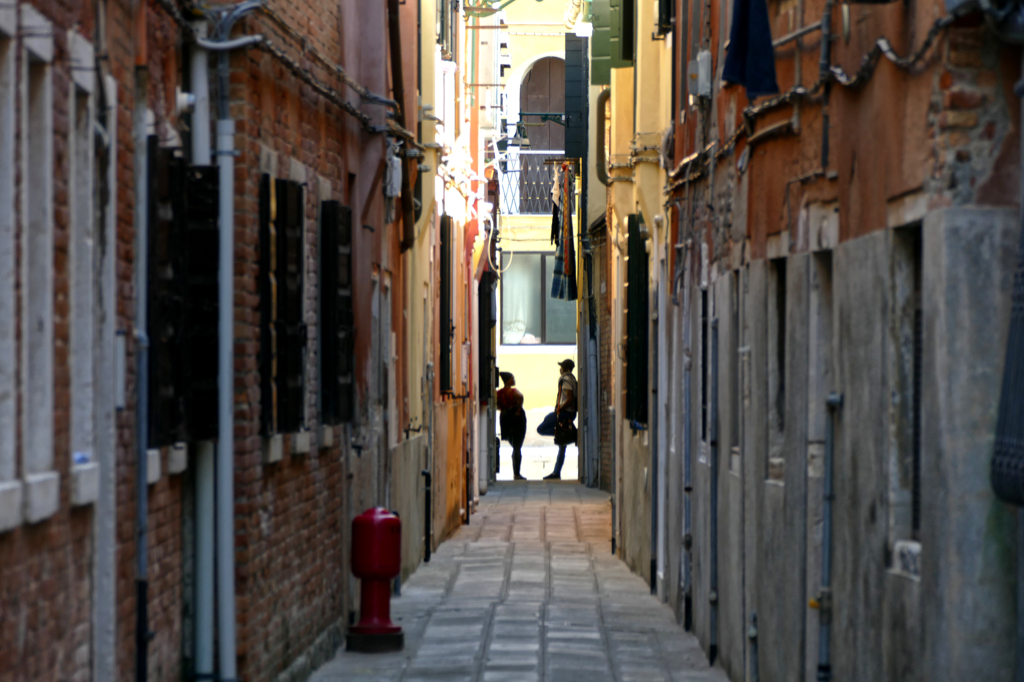
However, I’d argue it’s not worth getting to all those palaces. As a matter of fact, you can see them much better from a distance – and this means from the water most of the time.
Hence, the best way to see at least the palaces that are lining the Canale Grande is by taking a water bus. If you’re a billionaire, you can also charter a water taxi, obviously. Since I’m not, I went by vaporetto #1, Venice’s most popular water bus. It starts at the stop Piazzale Roma and goes all the way to the Lido di Venezia.
Take Your Time
Since just the ride on the Canale Grande between the train station and the San Zaccaria stop next to Saint Mark’s Square can take up to 90 minutes, you better make sure to get a good seat. As a matter of fact, the best seat for a palace cruise would be in the center of the small outside seating area in the back of the vaporetto. This way you’ll be able to see the palaces on both sides of the canal. Don’t even think about moving from side to side while the vaporetto glides down the canal. Unless you take a boat at six in the morning, the water bus will fill up with passengers quickly. During the high season, you might even have to wait for the next one since you cannot squeeze on the one you initially intended to take.

If you intend to take pictures, keep in mind that the canal is not straight but winds in the shape of a reversed S from west to east. I’m pointing this out because it has a strong impact on the light. You’ll never be able to see all those palaces perfectly illuminated by the sun in one go. Unfortunately, due to all that winding, it’s even impossible to get the perfect light on one bank in the morning and consequently on the other in the afternoon. However, with the help of my map and some basic knowledge of the course of the sun, you should be able to figure out which hour will be best for taking pictures of your favorite palaces.
Which Ticket to Buy
To sail down the Canale Grande, you need a ticket, obviously. If you just want to take one trip, an individual ticket will do. However, while at 9.50 €uros, individual tickets are ridiculously expensive, there are travel passes that are actually not that bad. Hence, you might want to consider getting one of those.

Obviously, the more days you buy, the cheaper your individual rides. Here is a chart on how much you pay for a day pass in 2024:
| 24 hours | 48 hours | 72 hours | 168 hours (7 days) |
| 25 €uros | 35 €uros | 45 €uros | 65 €uros |
Also, note that you can use a 24-hour ticket on two days. The clock starts ticking the moment you validate your ticket and lasts actually 24 hours. With the other tickets, it’s the same, obviously.
Rolling Venice
Young people under 29 years of age get an even better deal with the Rolling Venice Card. This title costs 6 €uros and is valid for one whole year. Not only do you get great discounts at many museums and other places of interest. You also pay only 22 €uros for a 72 hours-pass instead of the regular 40 €uros. Unfortunately, you can actually buy only 72 hours-passes. But if you stay for instance for a week, you can get two so that you pay only 44 €uros in total.

The passes are also valid in other parts of the Venetian area like for instance on the buses on the Lido di Venezia and on buses, trains, and the tram in Mestre. All in all, they are a really great deal.
Rules And Regulations
In the past, basically no one really cared if you paid for your Vaporetto trip or if you just hopped on the ferry and off you went. Yet, this changed dramatically. During my week in Venice this year, I was checked five times! Also, I witnessed how the inspectors could not be talked into anything or charmed. If a passenger did not have a valid ticket, he had to pay 9.50 €uros for the regular fare plus a fine of 50 €uro.
Nevertheless, the inspectors granted them two options: cash or credit card payment.

Also, here’s a little technical tip: If you have a valid ticket and the turnstile still refuses to let you through when you tap, you’ve definitely tapped at the wrong entrance. At busy stations such as Piazzale Roma or Ferrovia, there are actually two entrances: One for tourists and one for residents. When the Vaporetto arrives, the passengers in the resident queue have priority boarding. I think this is a very practical and fair solution. Since the residents are already so disturbed by the masses of tourists, they should at least have priority when taking the Vaporetto.
So if your perfectly good ticket declines, try the other entrance.
Venice Entrance Fee
Yes, it’s true: In its fight against merciless over-tourism, Venice has installed an entrance fee.
While the visitors are all freaking out and panicking about being thrown into the dungeon forever because they were caught without a valid ticket, the Italians take it rather easy.

It is a pilot project that has been applied on certain days – mostly weekends – since April. You have to pay 5 €uros online if you are in the Centro Storico on the designated days between 8.30 a.m. and 4 p.m. You don’t have to pay anything if you stay overnight in the greater Venice area. That’s for example in Mestre on the mainland. Neither do you have to pay anything if you’re just on the smaller islands like Murano, Burano, Torcello, and the Lido. You also don’t have to pay if you’re just changing buses in Piazzale Rome or trains at Stazione Santa Lucia.
And who controls all that? In my experience, no one.
However, since the amount is really manageable, I would pay it.
You can get more info on this website, and here, you can pay your dues or obtain an exemption.
Legal Trespassing
During the Biennale di Arte, which until the covid pandemic has taken place every odd-numbered year, many of the old palazzi are housing the so-called country-pavilions. While these buildings normally cannot be accessed as you please, during this mega art event, you get to see outstanding art at outstanding structures – for free! From 2022 on, the Biennale takes place during even-numbered years.

In my last post, I’m introducing the current Biennale di Arte. If you want to visit this mega-event in Venice in 2022, you should definitely rush over and check it out.
Venice’s around 200 palaces – many of them built alongside the Canale Grande – are a major part of the city’s splendor. To read about other attractions like for instance the art event Biennale di Arte, go to the general post on Venice! There, you’ll find valuable general information and most of all great hacks on how to visit the city without burning a hole into your wallet.
Map
This map should help you to find the most iconic Palaces in Venice. Clicking on the slider symbol at the top left or the full-screen icon at the top right will display the whole map including the legend.
Pinnable Pictures
If you choose to pin this post for later, please use one of these pictures:

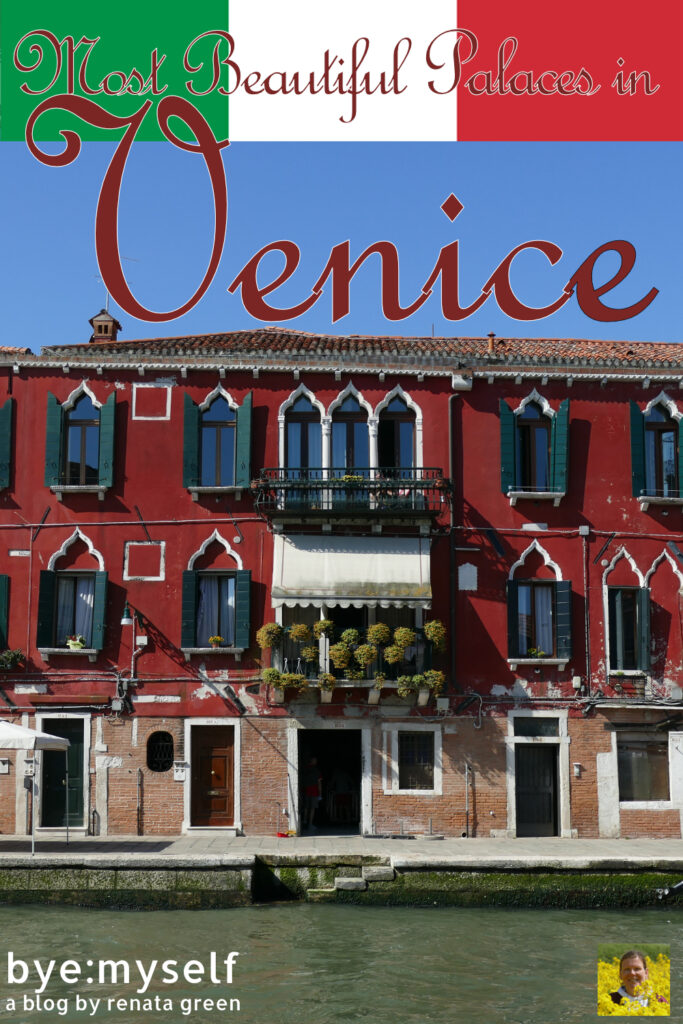

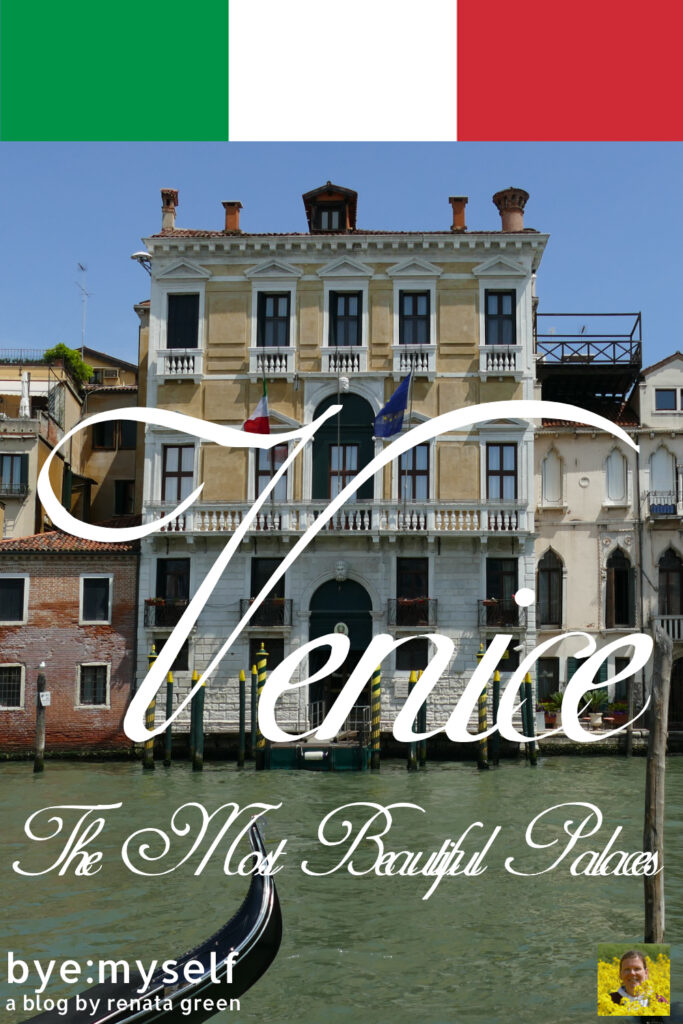
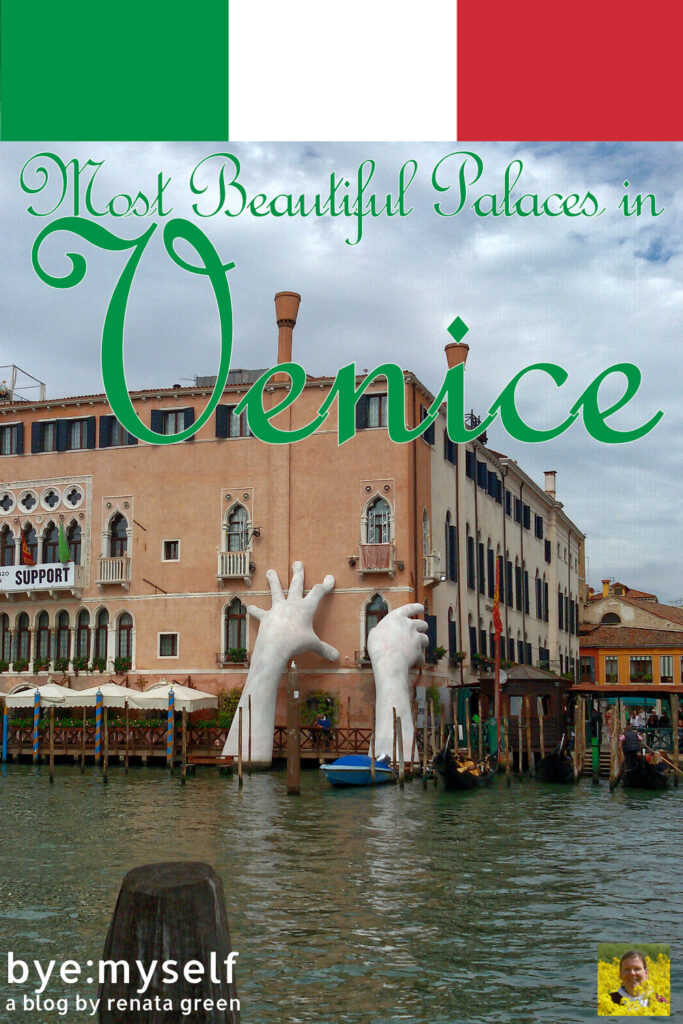
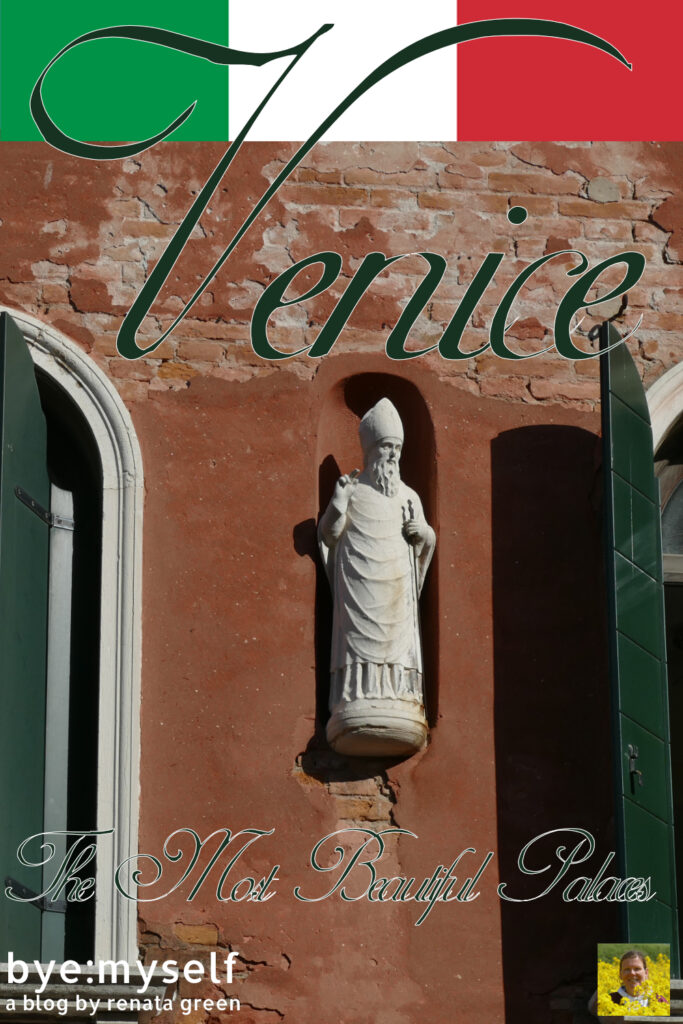
Did You Enjoy This Post? Then You Might Like Also These:
Back to School: Italian Classes at the Scuola Leonardo da Vinci
Comprehensive Guide to FLORENCE – Home of the Medici, Cradle of the Renaissance
TIVOLI – Villas, Waters, and Wealth. A Day Trip from Rome
How to Visit the Biennale di Arte in Venice in 2022
TORCELLO – a church, a bridge, and 15 residents
50 Most Beautiful Palaces in Venice
LA SPEZIA and PORTO VENERE – Precious Gems on the Ligurian Coast
Day Trip to the LIDO di VENEZIA. Breaking Away from Venice
* This is an affiliate link. Hence, If you book through this page, not only do you get the best deal. I also get a small commission that helps me run this blog. Thank you so much for supporting me!


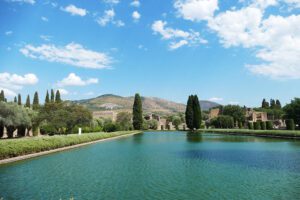
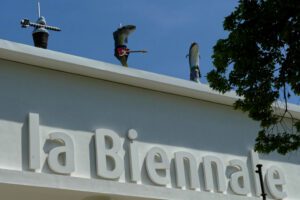




Gosh! I fell in love especially Venice is in my travel bucket list 🙂 Thanks for sharing as if I already went there, love the photos, amazing!!
The architecture of all of them is spectacular, however, where did the children play lol. I guess they were too wrapped up in showing how much money they had. I prefer the castles hidden behind trees.
That’s such an excellent point! I hope they were all good swimmers 😀
it always fascinated now heavily loaded Venice is with beauty. I thought I have seen and enjoyed it all but I do hardly remember half of your list. it only makes me come back and explore Venice more!
Your list is impressive. Despite spending the weekend in Venice, I haven’t managed to see all the places you write about yet.I hope to come back and use your tips.
I didn’t mean to evoke any FOMO 😉 it’s just an inspiration 😀
I will take your advice anD take Vaporetto#1 instead of walking the maze. Such a huge city of grandeur!
This is an incredible list, and as someone who lives nearby, I didn’t know over 75% of these names! So many stand out, but I love Palazzo Genovese and Ca d’Oro. Venezia is always a joy to see!
This truly sounds like an adventure. I had no idea that this series of palaces even existed! Navigating the canals definitely sounds like a challenge that I would be up for. Great post! Thanks for sharing.
Yes, I somehow felt the need to make a round-up. Glad you like it 🙂
Venice is very beautiful. I have been fascinated with it ever since my mom read me Come Over to My House by Dr. Suess when I was a kid. I thought it was so cool getting around by gondola and seeng streets of water.
The first time I visited, I was totally blown away. And my heart still skips a beat every time I arrive in Venice 🙂
You’ve just proven that there are endless beautiful sites in Venice. I loved reminiscing about my last trip here and reliving it through your photos that I instantly recognized. But I do have to say there were some Palazzo that I never got to see. My favourite thing to do in Venice was simply to get lost in the tiny winding, crooked streets. Thanks for the memories!
You’re very welcome! Yes, getting lost in the alleys and returning to the same spot again and again is an important part of every Venice-trip 😀 😀 😀
It was amazing to look at your list of the 50 most beautiful palaces in Venice. Even after visiting several times I now know that many more visits will be needed to see all these gems. I love that many can be seen just cruising the canals. But was happy to see ones off the beaten tourist path. I love the idea of wandering the maze of bridges and canals to discover new treats.
Wandering through those mazes is fun when you’re just meandering around. When you’re looking for a specific place, those mazes make you furious 🙁 However, it got better with the invention of google maps 😉
Venice has so beautiful architecture! It was very interesting to read the history behind them. Those cruises are so bad and its crazy how many people still travel with them to there. lets hope this would change one day.
Yes, I also hate cruise liners – they truly destroy the planet – so sad! 🙁